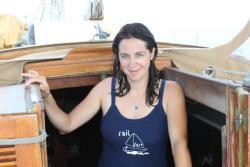 The southern flow of the Labrador Current and the northern flow of the Gulf Stream collide off of Cape Hatteras, North Carolina. This disturbs the water and forms shifting shallow sandbars known as the Diamond Shoals up to 14 miles offshore that have sunk enough boats to earn the area the nickname the "Graveyard of the Atlantic". That is why we have repeatedly avoided going outside around the cape on our previous trips up and down the coast, instead favoring a three-day trip inside on "the ditch" as the Intracoastal Waterway is often referred.
The southern flow of the Labrador Current and the northern flow of the Gulf Stream collide off of Cape Hatteras, North Carolina. This disturbs the water and forms shifting shallow sandbars known as the Diamond Shoals up to 14 miles offshore that have sunk enough boats to earn the area the nickname the "Graveyard of the Atlantic". That is why we have repeatedly avoided going outside around the cape on our previous trips up and down the coast, instead favoring a three-day trip inside on "the ditch" as the Intracoastal Waterway is often referred.
St. Augustine, Florida
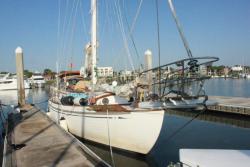 The trip started in our sailboat's home port of St. Augustine, Florida. We'd left our boat there the previous fall after a freezing, rushed trip south from Annapolis, Maryland. We'd been aiming for warm Florida waters, but were greeted by sub-freezing 30 degree temperatures when we tied the boat to the Florida dock. A couple of whirlwind days were spent getting the boat winterized, then we flew north to Alaska for the winter. A month later while Jamie was working in the same Ketchikan hospital where I'd been born some three and a half decades earlier, our friend and sailing mentor, Bill (aka "Captain Ron"), flew down to live on our boat, using her as a home base for his own boat shopping and kindly doing some much needed repairs and improvements.
The trip started in our sailboat's home port of St. Augustine, Florida. We'd left our boat there the previous fall after a freezing, rushed trip south from Annapolis, Maryland. We'd been aiming for warm Florida waters, but were greeted by sub-freezing 30 degree temperatures when we tied the boat to the Florida dock. A couple of whirlwind days were spent getting the boat winterized, then we flew north to Alaska for the winter. A month later while Jamie was working in the same Ketchikan hospital where I'd been born some three and a half decades earlier, our friend and sailing mentor, Bill (aka "Captain Ron"), flew down to live on our boat, using her as a home base for his own boat shopping and kindly doing some much needed repairs and improvements.
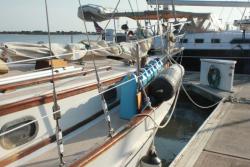 By the time we returned to the boat in the spring, the cold weather had finally broken. Still dreaming of crossing the Atlantic later in the summer, we tackled a number of projects to prepare for the open ocean. Jamie spent long hours sanding and beautifully coating boards with Bristol Finish, lashing them to the stays just forward of our mast on either side of the boat. We then lashed water jugs, fuel jugs and fenders to the boards, making for a safer deck with an easier to navigate passageway free of the clutter we'd grown used to.
By the time we returned to the boat in the spring, the cold weather had finally broken. Still dreaming of crossing the Atlantic later in the summer, we tackled a number of projects to prepare for the open ocean. Jamie spent long hours sanding and beautifully coating boards with Bristol Finish, lashing them to the stays just forward of our mast on either side of the boat. We then lashed water jugs, fuel jugs and fenders to the boards, making for a safer deck with an easier to navigate passageway free of the clutter we'd grown used to.
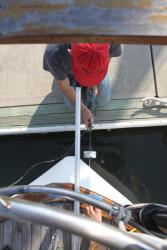 Last fall at the sailboat show in Annapolis, we'd ordered a Cape Horn Windvane. This ingenious device steers a boat using only wind and water, a must for any long distance cruising. The windvane's creator, Yves, had crawled into our engine room after the boat show and taken careful measurements allowing him to custom craft a small tiller that would attache the device to our reverse-mounted worm gear steering system. And though having retired from sailboat installations several years earlier, Yves agreed to spend the weekend with us in Florida helping me to install the windvane.
Last fall at the sailboat show in Annapolis, we'd ordered a Cape Horn Windvane. This ingenious device steers a boat using only wind and water, a must for any long distance cruising. The windvane's creator, Yves, had crawled into our engine room after the boat show and taken careful measurements allowing him to custom craft a small tiller that would attache the device to our reverse-mounted worm gear steering system. And though having retired from sailboat installations several years earlier, Yves agreed to spend the weekend with us in Florida helping me to install the windvane.
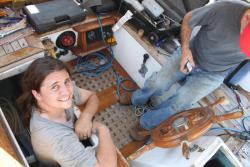 The weekend was spent with long hours measuring, re-measuring, cutting, drilling, screwing, epoxying and ultimately installing the Cape Horn on and through the stern of our 37 foot sailboat. Yves proved to be an entertaining companion, working hard by day, and sharing tales at night of his around the world trip and many other sailing adventures, stories told over glasses of red wine.
The weekend was spent with long hours measuring, re-measuring, cutting, drilling, screwing, epoxying and ultimately installing the Cape Horn on and through the stern of our 37 foot sailboat. Yves proved to be an entertaining companion, working hard by day, and sharing tales at night of his around the world trip and many other sailing adventures, stories told over glasses of red wine.  The idea was for me to do all the manual labor while he guided me to ensure a proper installation -- in fact, he did much of the physical work himself, with a softly muttered comment like, "this has to be done right". And done right it was, a beautiful piece of craftmanship that dramatically improves our quality of life while under sail.
The idea was for me to do all the manual labor while he guided me to ensure a proper installation -- in fact, he did much of the physical work himself, with a softly muttered comment like, "this has to be done right". And done right it was, a beautiful piece of craftmanship that dramatically improves our quality of life while under sail.
Onward, Carolinas
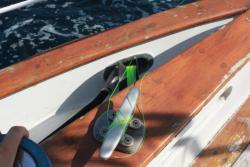 We cast off in the late morning, waving goodbye to the other liveaboards that had become our friends at the Conch House Marina. Outside on the open ocean the weather was amazing, the sun shining, a light breeze, and reasonably calm following seas. We motor-sailed along, hoping for the winds to pick up enough to sail without motor.
We cast off in the late morning, waving goodbye to the other liveaboards that had become our friends at the Conch House Marina. Outside on the open ocean the weather was amazing, the sun shining, a light breeze, and reasonably calm following seas. We motor-sailed along, hoping for the winds to pick up enough to sail without motor. 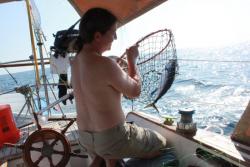 I quickly dug out one of the "yo-yo's" Jamie purchased from a St. Augustine fishing tackle store the day before, a simple $10 fishing device that actually looks like an oversized yo-yo. It removes the need for a bulky fishing pole, an item we've always struggled to store in our space-deficient floating home. With the "yo-yo", you attach a lure to the end and unwind sufficient line,
I quickly dug out one of the "yo-yo's" Jamie purchased from a St. Augustine fishing tackle store the day before, a simple $10 fishing device that actually looks like an oversized yo-yo. It removes the need for a bulky fishing pole, an item we've always struggled to store in our space-deficient floating home. With the "yo-yo", you attach a lure to the end and unwind sufficient line, 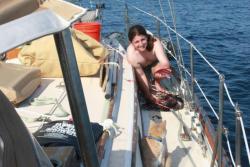 then simply cleat off the other end to the boat. Within an hour we'd caught our first fish, a tasty, red-fleshed Atlantic Bonito.
then simply cleat off the other end to the boat. Within an hour we'd caught our first fish, a tasty, red-fleshed Atlantic Bonito.
Quixote, our faithful boat cat, is fascinated by the entire fishing process. Most of all, however, he appreciates the 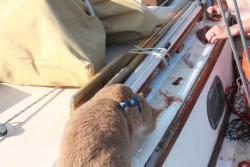 cleaning process which allows him to gorge on an all-you-can eat buffet of bloodline, the dark stripe of extra-fishy tasting meat that we would otherwise give as an offering to Poseidon. My time commercial fishing in Alaska serves me well, allowing me to quickly process the fish which ends up in plastic bags set against the
cleaning process which allows him to gorge on an all-you-can eat buffet of bloodline, the dark stripe of extra-fishy tasting meat that we would otherwise give as an offering to Poseidon. My time commercial fishing in Alaska serves me well, allowing me to quickly process the fish which ends up in plastic bags set against the  cold plates in our icechest. Jamie promised fish-tacos for dinner, a promise she delivered on that night in great style.
cold plates in our icechest. Jamie promised fish-tacos for dinner, a promise she delivered on that night in great style.
I spent much of the late afternoon experimenting with the windvane in the light breeze, learning how it worked and wishing we had a enough wind to use it properly. As night fell, air from the rapidly cooling but many-miles-distant invisible land rushed out to sea replacing warm air rising off the ocean. The breeze continued to pick up as the sun set, 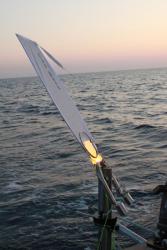 until it was sufficient to let our boat self-steer for the first time, an utterly magical feeling after years of steering her only by hand. We happily wandered the deck together watching dolphins play alongside in the setting sun, and behaving as the newlyweds we were. We felt happily lost in the vast freedom of the open ocean, wind powering us into our first star-lit nightsail of the year.
until it was sufficient to let our boat self-steer for the first time, an utterly magical feeling after years of steering her only by hand. We happily wandered the deck together watching dolphins play alongside in the setting sun, and behaving as the newlyweds we were. We felt happily lost in the vast freedom of the open ocean, wind powering us into our first star-lit nightsail of the year.
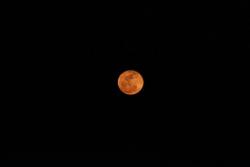 The night was soon filled with our favored navigation companion full in the sky. Sailing through the dark of night evokes bipolar emotions, ranging from base fear to unmitigated elation. I thought back to my worries from the night before while tied safely to the dock, fear of the unknown. Now, 15 miles from shore under a sky of stars and a full moon, surrounded by curious dolphins and a refreshing breeze, fear seemed silly.
The night was soon filled with our favored navigation companion full in the sky. Sailing through the dark of night evokes bipolar emotions, ranging from base fear to unmitigated elation. I thought back to my worries from the night before while tied safely to the dock, fear of the unknown. Now, 15 miles from shore under a sky of stars and a full moon, surrounded by curious dolphins and a refreshing breeze, fear seemed silly. 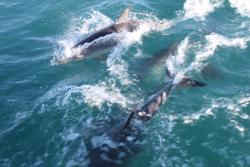 We were well on our way, following the course we'd plotted the night before that entirely skipped the coast of Georgia, first bringing us near land off of Charleston, SC. If weather cooperated, we'd continue north without stopping, aiming instead for Beaufort, NC, the northern most entrance before Cape Hatteras.
We were well on our way, following the course we'd plotted the night before that entirely skipped the coast of Georgia, first bringing us near land off of Charleston, SC. If weather cooperated, we'd continue north without stopping, aiming instead for Beaufort, NC, the northern most entrance before Cape Hatteras.
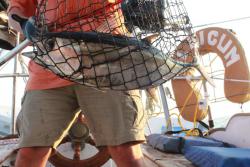 Day two brought us more bounty from the sea in the form of a 30 pound Bigeye Tuna. Suddenly our little Bonito no longer seemed tasty when compared with the 'ahi that was filling our icebox, one of our most favorite of all fishes.
Day two brought us more bounty from the sea in the form of a 30 pound Bigeye Tuna. Suddenly our little Bonito no longer seemed tasty when compared with the 'ahi that was filling our icebox, one of our most favorite of all fishes. 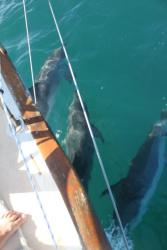 The yo-yo was proving a formidable provider, and we found ourselves with more fish than we knew what to do with. When using a fishing pole, we're constantly fighting weeds and dealing with strikes where a fish bites but doesn't get hooked. With the yo-yo's we're
The yo-yo was proving a formidable provider, and we found ourselves with more fish than we knew what to do with. When using a fishing pole, we're constantly fighting weeds and dealing with strikes where a fish bites but doesn't get hooked. With the yo-yo's we're 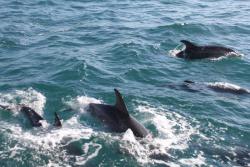 oblivious to all the false-strikes, and only become aware of having a fish when it's hooked well enough even my clumsy netting can't set it free. Having caught two fish, we wound the line around the cheap plastic yo-yo's and stored them below, safe and out of the way, ensured of forever replacing fishing poles on our sailboat.
oblivious to all the false-strikes, and only become aware of having a fish when it's hooked well enough even my clumsy netting can't set it free. Having caught two fish, we wound the line around the cheap plastic yo-yo's and stored them below, safe and out of the way, ensured of forever replacing fishing poles on our sailboat.
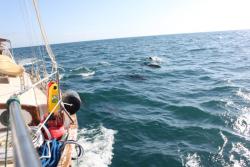 Pod after pod of dolphin sought out the wake of our boat, playing on both sides and favoring the bow. Occasionally we'd spot a dolphin with scars identical to a dolphin we'd seen the day before, and we would wonder if we were journeying on the same long-distance currents together.
Pod after pod of dolphin sought out the wake of our boat, playing on both sides and favoring the bow. Occasionally we'd spot a dolphin with scars identical to a dolphin we'd seen the day before, and we would wonder if we were journeying on the same long-distance currents together.
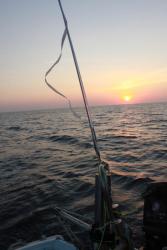 The winds were light, enough to keep the sail full but requiring motor assistance to keep us above our 5 knot goal. I learned to balance the windvane while motor sailing, when the wind dropped off too much you'd have to adjust it but it meant checking our course every 10 minutes rather than constantly. As the second night approached and the sea remained kind,
The winds were light, enough to keep the sail full but requiring motor assistance to keep us above our 5 knot goal. I learned to balance the windvane while motor sailing, when the wind dropped off too much you'd have to adjust it but it meant checking our course every 10 minutes rather than constantly. As the second night approached and the sea remained kind, 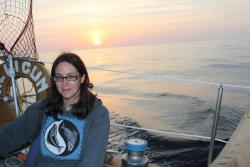 it became clear that we weren't going to be stopping in Charleston after all.
it became clear that we weren't going to be stopping in Charleston after all.
Night on the sea for Jamie and I is about stars and dolphins and warm drinks and music. We enjoy our soltitude wrapped up in a blanket, and music is never more powerful than while leaning back to pick out constellations and dream. 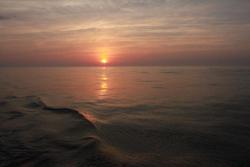 We sip our coffee or tea, taking turns on watch while the other sleeps below on the settee. Three hours awake in the cockpit, three hours asleep below, trading places throughout the night. More tired the second night, I took to setting my phone alarm for fifteen minute intervals and allowed myself to drift off, lulled to sleep by the gently rocking boat. Each time the alarm went off I'd stand up and carefully scan the entire horizon for lights and anything else, verifying our course and adjusting the windvane if necessary before laying back down for another outdoor catnap.
We sip our coffee or tea, taking turns on watch while the other sleeps below on the settee. Three hours awake in the cockpit, three hours asleep below, trading places throughout the night. More tired the second night, I took to setting my phone alarm for fifteen minute intervals and allowed myself to drift off, lulled to sleep by the gently rocking boat. Each time the alarm went off I'd stand up and carefully scan the entire horizon for lights and anything else, verifying our course and adjusting the windvane if necessary before laying back down for another outdoor catnap.
Graveyard of the Atlantic
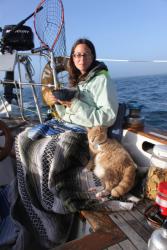 On our third day, the sun continued to shine and the seas remained relatively calm. The breeze again died down as soon as the sun came up, but we had plenty of fuel and a growing love for our dolphin companions and the open ocean. We listened to a few forecasts on the VHF and discussed our options.
On our third day, the sun continued to shine and the seas remained relatively calm. The breeze again died down as soon as the sun came up, but we had plenty of fuel and a growing love for our dolphin companions and the open ocean. We listened to a few forecasts on the VHF and discussed our options. 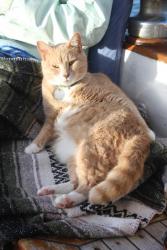 Jamie had a job starting soon in Baltimore, and I had a job that would require a week in Kansas starting the following weekend -- we didn't have much time to finish our journey up the coast and into the Chesapeake. With the weather cooperating so well, we concluded it would only make sense to round the Cape for our first time and take the outside route all the way into the bay, shaving 24 hours off our travel time.
Jamie had a job starting soon in Baltimore, and I had a job that would require a week in Kansas starting the following weekend -- we didn't have much time to finish our journey up the coast and into the Chesapeake. With the weather cooperating so well, we concluded it would only make sense to round the Cape for our first time and take the outside route all the way into the bay, shaving 24 hours off our travel time.
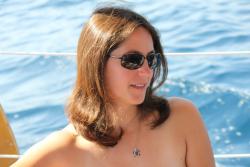 We took advantage of the sunshine and mellow seas, setting up our solar shower on the bow. With insufficient wind to self-steer, we took turns lathering up with soap and shampoo, feeling utterly decadent to be naked and clean in the refreshing sunshine.
We took advantage of the sunshine and mellow seas, setting up our solar shower on the bow. With insufficient wind to self-steer, we took turns lathering up with soap and shampoo, feeling utterly decadent to be naked and clean in the refreshing sunshine. 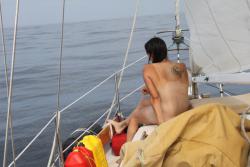 Invigorated, any lingering doubts we may have had were washed away and we pointed the bow straight out to sea off of the Frying Pan Shoals.
Invigorated, any lingering doubts we may have had were washed away and we pointed the bow straight out to sea off of the Frying Pan Shoals. 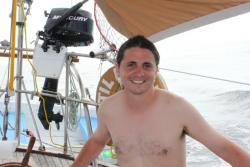 We were aiming to find the Gulf Stream some 25 to 35 miles offshore, which we intended to ride gaining a northern boost of a couple knots around the Cape.
We were aiming to find the Gulf Stream some 25 to 35 miles offshore, which we intended to ride gaining a northern boost of a couple knots around the Cape. 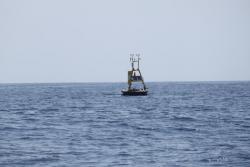 We passed buoys and observation decks that were many miles out of sight of land, steering close when opportunity allowed to take a look. We finally found the current as the sun set, enjoying another amazing tuna meal and a few hours of engine silence thanks to the evening breeze. The next day would find us approaching the one place we'd long feared to venture.
We passed buoys and observation decks that were many miles out of sight of land, steering close when opportunity allowed to take a look. We finally found the current as the sun set, enjoying another amazing tuna meal and a few hours of engine silence thanks to the evening breeze. The next day would find us approaching the one place we'd long feared to venture.
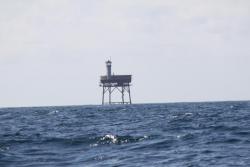 On day four we finally started rounding Cape Hattaras. The ocean swells grew upwards of eight feet, raising and lowering our boat as if it were a child's bathtub toy. The wind was still calm though so it was a gentle rocking with the occasionally slamming when a wave would happen to break alongside us. The feeling of total isolation was broken by the many small sport-fishing craft that had dropped a line off the cape, many coming within a boat length of us as they followed their trolling paths.
On day four we finally started rounding Cape Hattaras. The ocean swells grew upwards of eight feet, raising and lowering our boat as if it were a child's bathtub toy. The wind was still calm though so it was a gentle rocking with the occasionally slamming when a wave would happen to break alongside us. The feeling of total isolation was broken by the many small sport-fishing craft that had dropped a line off the cape, many coming within a boat length of us as they followed their trolling paths.
The idyllic evening was abruptly interrupted when a large wave crashed over our stern, pooping the dinghy we had hanging from our davits. With a loud bang, one of the ancient lines that had been holding the dingy up snapped under the added water weight and it all came crashing down. Jamie and I jumped to work and freed the dinghy, allowing it to trail behind us as we surveyed the damage. It seemed the windvane rudder had been knocked free by the falling dinghy and was floating on its tether behind our stern. Short on better ideas, I climbed into our eight foot dinghy and rode equally tall waves as I attempted a fix. It was a unique viewpoint, standing in a tiny plastic boat miles from land over the Graveyard of the Atlantic, watching the sun set. Suddenly surfing down a following sea that threatened to hurl me into the sailboat I was dragging behind, I abruptly shifted from my poetic appreciation of the beauty of it all to fearing for my life. It was clear that doing anything from the dinghy wasn't going to be wise, so as quickly as I could I dragged myself back into the sailboat.
Leaning over the stern I discovered that the windvane rudder hadn't just been knocked free, it had actually been snapped in half with the weight of the water logged dinghy. I pulled the pieces aboard and we sadly acknowledged that our final night would be spent hand-steering without the much appreciated assistance of the windvane. Our fourth sunset of the trip found Cape Hatteras to our stern, and as we aimed for the mouth of the Chesapeake, the Cape began to block the incoming seas, calming the water.
Chesapeake Bay, By Way Of Ocean
A Virginia warship hailed us long after sunrise the fifth day, warning that their intended course would require us to give them room. I responded over the VHF that we were traveling under sail power alone and would require time to manuveur in the light winds. Their delayed reply instructed us to maintain our course as they'd instead move out of our way. We laughed in silly happiness that our sails and light fiberglass had won against their many tens of tons of steel.
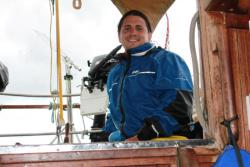 The coastline came closer and we finally spotted the entrance to the Chesapeake Bay, where the Chesapeake Bay Bridge-Tunnel crosses the mouth between Virginia Beach and Cape Charles. Ugly storms were brewing over our shoulder and ahead over the southern shore, so we were happy to be ending our longest open ocean passage to date. We called ahead to the Hampton Roads city dock and reserved a slip which we expected to reach around 6pm. Inside the bay,
The coastline came closer and we finally spotted the entrance to the Chesapeake Bay, where the Chesapeake Bay Bridge-Tunnel crosses the mouth between Virginia Beach and Cape Charles. Ugly storms were brewing over our shoulder and ahead over the southern shore, so we were happy to be ending our longest open ocean passage to date. We called ahead to the Hampton Roads city dock and reserved a slip which we expected to reach around 6pm. Inside the bay, 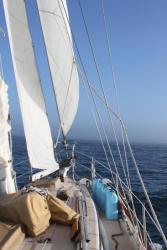 the weather took a turn for the worse. We'd seen it coming and had plenty of time to lower our Jib and Main sails, cruising along under motor power and a staysail alone. The weather station at the top of our mast reported a 40 knot gust as the sudden winds took ahold, heeling us far over and pushing us along above hull speed to nearly 8 knots. Another warship was exiting the channel again on a collision course, and this time we gave into the laws of gross tonnage and veered into the howling winds and rain to give them their desired space.
the weather took a turn for the worse. We'd seen it coming and had plenty of time to lower our Jib and Main sails, cruising along under motor power and a staysail alone. The weather station at the top of our mast reported a 40 knot gust as the sudden winds took ahold, heeling us far over and pushing us along above hull speed to nearly 8 knots. Another warship was exiting the channel again on a collision course, and this time we gave into the laws of gross tonnage and veered into the howling winds and rain to give them their desired space.
Over as quickly as it started, our wet decks glistened in the afternoon sun. We threaded our way into Hampton Roads, happy to have a place not too far out of the way to rest up before the final push to Baltimore. Dining on our endless stocks of fresh tuna, we arrived within minutes of the predicted time thanks to the wonders of GPS, and stepped onto Virginia soil after five days at sea. While a far cry from crossing an ocean, it was another big milestone in our sailing experience, and a magical and wonderful trip.
Mon, 08/15/2011 - 20:34
These are the trips we dream about, and never forget. The students have become the teachers, and it is a joy to see. Thanks for sharing such a wonderful adventure!